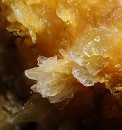
|
| Alunogen |
Chemical
Formula |
Al2(SO4)3·17H2O |
Species |
Sulfates |
Crystal
System |
Triclinic |
Mohs
Scale |
1-2 |
Color |
Colorless in crystals, aggregates white, or pale yellow or red from impurities. |
Streak |
White |
Luster |
Vitreous, Silky |
Refractive
Index |
n = 1.473 n = 1.474 n = 1.480 |
Diaphaneity |
Transparent |
| Crystal Habit:Crystals rare, small; prismatic or with a hexagonal outline about ; very complex, with about 60 forms noted. Commonly as delicate fibrous masses or crusts; effloresences; massive, fibrous to 5mm. |
Geological Setting:Forms by reaction of sulfates from decomposing sulfides with aluminous minerals in shales and slates; in gossan or altered wall rock of pyritic deposits in arid regions; in coal seams;
in relatively low-temperature fumaroles. |
Alunogen also called
feather alum and
hair salt is a colourless to white (although often coloured by impurities, like iron substituting for aluminum) fibrous to needle-like aluminium sulfate mineral often found on the walls of mines and quarries as secondary mineral. It can be found in the oxidation zones of some ore deposits as well as on burning coal dumps (i.e. as the product of millosevichite hydratation).
Alunogen has the chemical formula Al2(SO4)3·17H2O. More precise, crystallochemical formula, can be written as: [Al(H2O)6]2(SO4)3.5H2O. The second formula shows that H2O in the alunogen formula occurs both as ligand (coordinative form) and loosely-bounded (crystallization) form. The second form can be easily removed just by slight grinding of the mineral (preserving the unique structure).


 YueGongAnBei 44051102000467
YueGongAnBei 44051102000467


 |
|